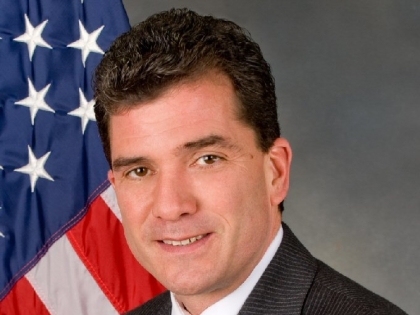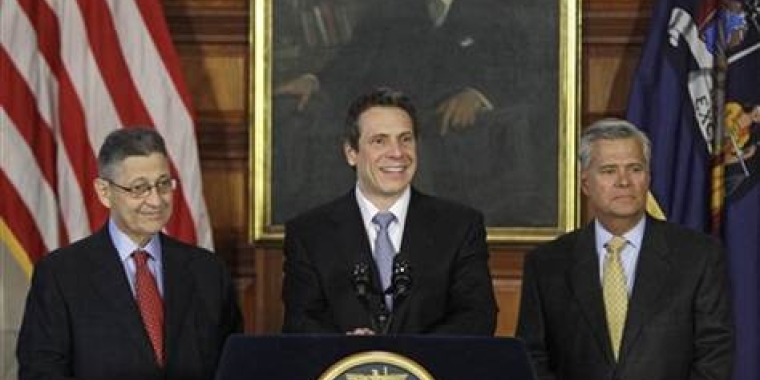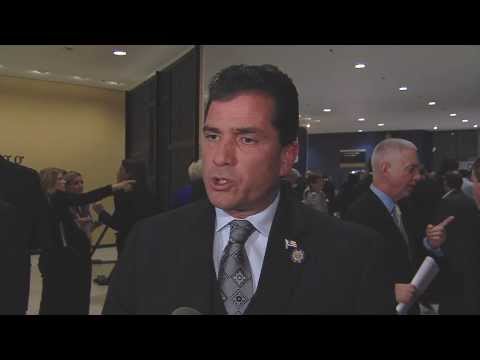
Gov. Cuomo, Senate Majority Leader Skelos and Assembly Speaker Silver Reach Agreement on 2011-12 New York State Budget
Mark Grisanti
March 27, 2011
-
ISSUE:
- Constituents Corner

Governor Andrew M. Cuomo, Senate Majority Leader Dean Skelos and Assembly Speaker Sheldon Silver today announced an agreement on a 2011-2012 budget that eliminates a $10 billion deficit.
The agreement includes historic reforms that redesign state government, create efficiencies through consolidation, cap spending increases for education and Medicaid, and transform the future budgeting process.
The approximately $132.5 billion budget will reduce spending overall by over 2 percent from the current year, eliminate 3,700 prison beds, establish regional economic development councils, bring performance funding to education, redesign Medicaid, and cap next year's education and Medicaid spending.
This budget reaches its financial goals with no new taxes and no borrowing, and will also cut next year's projected budget deficit from $15 billion to about $2 billion.
Recent changes to the budget include an additional $272 million in education which includes restoration of funding for schools for the blind and deaf (4201) and summer school special education. Human services funding of $91 million was added and $86 million for higher education including SUNY hospitals, SUNY and CUNY community colleges. There are also miscellaneous program additions of $33 million including aid to localities and agriculture programs. The budget proposal requires the Office of Court Administration (OCA) to reduce its budget by $170 million to reflect a more proportionate share of the state's reductions. There were also $54 million in miscellaneous cuts. As a result, the net add spending to this budget is approximately $250 million. In addition, there are no new member items.
"I have said that New York is at a crossroads – one road leading to further dysfunction and decline, the other towards fiscal responsibility and government efficiency. I believe this budget puts us on the right path," Governor Cuomo said. "This budget makes tough choices, which is what you sent me to Albany to do. It closes a $10 billion dollar deficit with no new taxes or borrowing, redesigns government to force it to cut waste and inefficiency, and finally delivers real results for hard-working families across New York State. I applaud and thank Majority Leader Skelos and Speaker Silver for working together to reach this agreement."
Senate Majority Leader Dean G. Skelos said, "This budget agreement keeps our Senate Republican commitment to reduce spending, cut taxes and empower the private sector to create jobs, and will begin to put New York on the path to fiscal recovery. By working together to reach consensus on a responsible spending plan that eliminates a $10 billion deficit without raising taxes, we have tightened our belt and protected middle-class families in every region of this State. I am particularly pleased with Governor Cuomo's commitment to making UB2020 a reality, which will bring jobs and hope to Western New York, as well as improvements to the other university centers, which are important priorities of our Senate Republican conference. Today's developments ensure we are moving full speed ahead to an on-time budget."
Assembly Speaker Sheldon Silver said, "Speaking for the Assembly Majority, I commend Governor Cuomo for his leadership in bringing about this agreement and for providing the Legislature with an executive budget that was strong and firmly grounded in reality. Government had to tighten its belt with the same sense of urgency that working families have been tightening their belts since the economy went into freefall in 2008. The sole consolation is that working with the Governor, we were able to achieve critical restorations which will soften the cuts affecting working families, our senior citizens, our most vulnerable populations and the children in our classrooms."
The 2011-2012 budget agreement contains critical components first proposed in Governor Cuomo's executive budget, including redesigning Medicaid and recalibrating the cost of state government, in part, by merging and consolidating agencies as well as curbing spending growth to sustainable and affordable levels.
Policy reforms in the 2011-2012 budget include:
- · Changing Permanent Law and Provides 2-Year Appropriations and Caps for Education and Medicaid: Education will be increased at a rate of personal income growth next year – roughly 4 percent. Medicaid will be increased at a rate tied to healthcare CPI which is roughly 4 percent. Together, these actions reduce next year's deficit from about $15 billion to about $2 billion and change decades-old practice of overspending.
· Redesigning the Medicaid System: The budget includes a global cap on State Medicaid expenditures of approximately $15 billion and implementation of the majority of recommendations by the Medicaid Redesign Team (MRT) to redesign and restructure the Medicaid program to be more efficient and get better results for patients. There are reallocations within the MRT cap that reduce some areas while targeting increases to others. Among the notable changes: the cap on medical malpractice is not included and EPIC is increased by $22 million. The MRT reduction of $2.8 billion and the overall spending cap to the state will be enforced by the Department of Health's "superpower" provision, whereby the commissioner has authority to make reductions during the year to enforce the cap.
- · Creating Regional Economic Development Councils: The budget establishes 10 Regional Economic Development Councils, chaired by Lieutenant Governor Robert Duffy. These councils will create a region-based approach to allocate economic development funds to speed up the creation of jobs. They will act as one-stop shop for all State-supported economic development and business assistance programs in each region, and will be supported with $130 million in capital that is reprogrammed from existing resources.
- · Creating the Recharge NY Power Program: Recharge New York will enhance and make permanent the current Power for Jobs Program that will significantly boost the state's economy by creating and maintaining hundreds of thousands of jobs. Recharge New York will improve upon the existing program by opening it to new participants and allocating a blend of stable, low-cost hydropower and market power for use by businesses that seek to grow and create jobs in New York state.
- · Authorizing the SAGE Commission: The budget authorizes Governor Cuomo's Spending and Government Efficiency (SAGE) Commission to reduce the number of agencies, authorities, and commissions by 20 percent. Currently, the consolidation of Parole and Corrections will save $16.8 million, the merging of NYSTAR into Department of Economic Development will save $1.9 million, and the merging of Consumer Protection into the Department of State will save $500,000.
- · Creating the Department of Financial Services: The budget merges the state's Banking and Insurance Departments into a new Department of Financial Services.
- · Authorizing Governor to Close Prisons: The state will eliminate 3,700 prison beds throughout New York at the sole discretion of the administration in consultation with the Legislature.
- · UB 2020: The Governor has also agreed to hold a summit with stakeholders to discuss how to make UB 2020 a reality.
- · Reforming the Juvenile Justice System: The budget includes significant reforms of the state's juvenile justice system by encouraging greater use of community-based alternatives, downsizing the state juvenile facilities system by more than 30 percent, and investing resources into enhanced services for juveniles that remain in OCFS custody.
- · Creating New Education Performance and Efficiency Grants: The budget enacts initiatives Governor Cuomo proposed to make districts more efficient and improve student performance. Funds totaling $500 million will be awarded competitively to districts that demonstrate significant improvements in student performance and to districts that undertake long term structural changes to reduce costs and improve efficiency. The budget also restores $270 million in education related funding.
- · Improving the Excelsior Jobs Program: As proposed in the executive budget, the budget strengthens the Excelsior Jobs Program, which was created in 2010 to provide job creation and investment tax credit incentives to businesses in targeted industries.
Share this Article or Press Release
Newsroom
Go to NewsroomWBEN 930-AM: Will 2014 Be MMA’s Year In New York?
December 26, 2013


